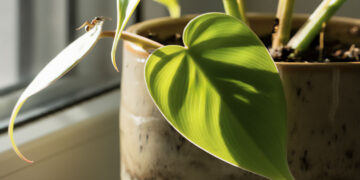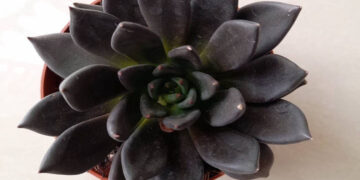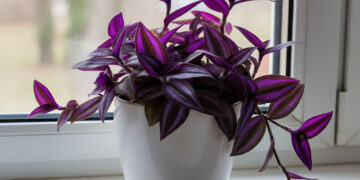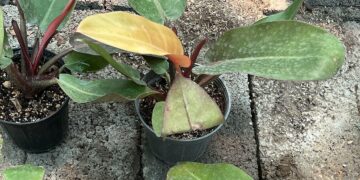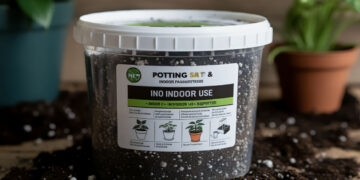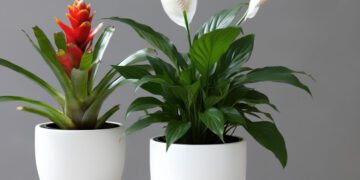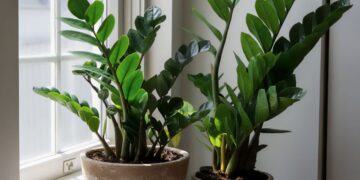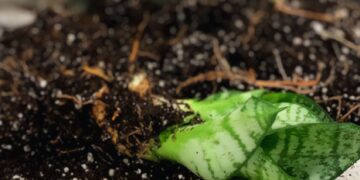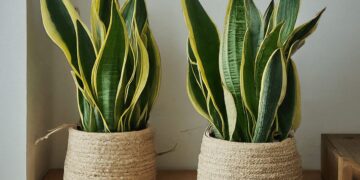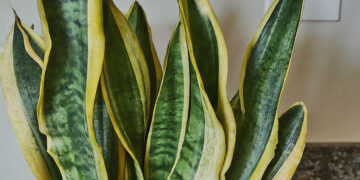
Some factors are effective in Snake plant growth. One of them is lighting. Light can harm the Snake plant just as it makes it develop. So, if you are interested to know how much Light a Snake plant needs in detail, carry on reading the following paragraphs.
How much light do Snake plants need?
Put your Snake plant in indirect sunlight for 5 to 8 hours daily. Low light will weaken it and make the leaves dull and unclear, while direct light will damage and burn its leaves.
Different snake plant species have slightly varied light requirements due to factors such as leaf structure, growth habits, color and native habitats. Variegated varieties like Sansevieria Laurentii (Mother-In-Law’s Tongue) need brighter light to maintain their distinctive leaf patterns, while all-green types like Sansevieria zeylanica are more tolerant of low light. Species with thicker leaves, such as Sansevieria cylindrica, can store more water, making them adaptable to varying light conditions.
Finding the perfect spot for your Snake Plant
If you recently bought a Snake plant or received it as a gift and you don’t know anything about Snake plant care, in order to prepare a suitable environment for the health of your plant, you must place it in a good spot, pay attention to the intensity of the light and do some regular care.
Best Indoor place for Snake plant
You may have seen snake plants in the corridors, offices, bathrooms and places with low light. However, the secret of leaf growth and freshness of Snake plant is placing it near North-facing windows with filtered light or somewhere a few feet away from east or west-facing windows.
I have been taking care of a Snake Plant at home for several years. If you ask me, I can say that the perfect place for it is next to the window with a sheer curtain. In this way, it grows well and makes your home unique too.
Quick ways to measure Light Intensity
You can check the quality of light with advice like light meter and help the Snake plant very easily by shadow Test. well, just hold your hand in front of the light. soft, dim shadows show that the light is indirect and otherwise the light is low.
In addition, trial and error is useful. After a while, If the leaves turn pale and snake plant growth rate goes down, the light is low and if you see brown tips on snake plant, the light is too much.
Artificial Light alongside the natural light for Snake Plants
It is true that natural light has the best results for Snake plants, but if your house is not bright enough, if you see signs of light stress, such as snake plant leaves turning yellow or stems longer than usual or winters with low light, you have not reached the end of the road. I am here to guide you on how to meet the Snake plant light needs with artificial lights.
Benefits of Natural Sunlight
Sunlight has a full spectrum and all the necessary wavelengths like red and blue for photosynthesis and growth, and it is free. you don’t need to pay for it.
The Right Artificial Lighting Solutions
If you are looking for cheap artificial light sources, I suggest Fluorescent Lights and If you want something adjustable with less energy, I should recommend LED Grow Lights. Keep an eye on where you put it and how many hours you turn it on to get the best results. I mean, place it at a distance of 12 to 18 inches from the Snake plant. If it is closer, it will burn the leaves, and if it is further away, it will not be effective. In fact, by using these devices, we are copying the cycle of day and night. So, when you turn it on for 10 to 14 hours, don’t forget the dark period.

Adjusting Light for Seasonal Changes
Just as the light becomes more or less at different times of the day, it also changes in different seasons. So, it is logical to switch the place of your Snake plant pot with a seasonal shift.
Spring and summer: There is more light, well put the Snake plant near the window to grow more.
Autumn and winter: when the days are short, and the light is low, use artificial light and place the plant near the south-facing windows to get more light.
Simple tips for perfect placement
Regular Rotation: It is important to rotate the Snake plant every few weeks so that the light shines on all sides of it.
Using sheer curtains: In addition to beauty, these curtains spread out the direct sunlight and keep your indoor plant from leaf burn.
Room heat and cold: The Snake plants prefer temperatures between 65 to 85°F (20-30°C). keep the temperature stable and stay away from hot and cold places such as drafts, heating vents, or cold windows.
Controlling the Snake plant’s health: Snake Plants don’t talk, but by seeing signs like yellow leaves, brown tips on snake plant show us whether the conditions are ideal or not.
Extra lighting: Adding artificial lights to natural when it is vital, is the best alternative to adjust plant light.
Common Light-Related Issues and Solutions
You should provide proper conditions from the beginning so that the snake plant does not have light problems, but it is never too late to mend. Just Identify the problem and solve it.
Preventive Measures for Optimal Light Conditions
As to light needs, Snake Plants are hard to beat. Clean their leaves often, pay attention to the change of light in different seasons and use high-quality grow lights.
Fault finding and Corrective actions in light problems
Avoid sudden changes in the Snake plant and Be careful with the response of it after each change. Even if the light is low, increase it slightly so that it does not get shocked. For this goal, reflective surfaces such as mirrors or white walls encourage the light well.

sources:
https://site.extension.uga.edu
Do you have any questions or experiences to share that could help me and other readers? Please comment below. Your insights are invaluable.


